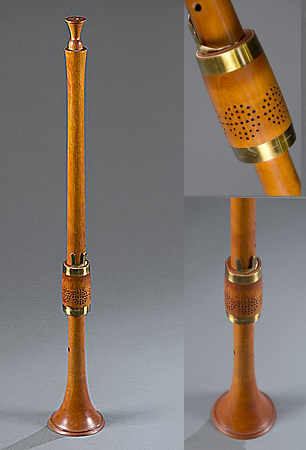
Owner: HWMC
Catalog#: 2CL-AERV-16
Double Reeds - Shawm
Renaissance 'Alto Schawm’
England
Eric Moulder (possibly)
Wood, brass
ca. 1970’s
Length: 33 in, Bell diameter: 4.75 in
Wind Instruments – Woodwind Instruments – Double Reeds – Shawm
Engraved on top section: “C R C / 77 19”
The term ‘shawm’ has been used to denote both single-reed and double-reed aerophones. Here we will be referring to the double-reed instruments used extensively in European art music from the 12th century to the 17th century and those experiencing a Renaissance revival in the 20th century.
During the 16th century we know that shawms came in various sizes with the first documented evidence from the Nuremberg woodwind instrument maker Sigmund Schnitzer the elder in 1539. He indicated that shawms were made in five different sizes ranging from sopranino to double bass.. The higher-pitched instruments retained their name, ‘shawm’, however, the term ‘bombarde’ or ‘bumbard’, a term from a medieval artillery piece, was sometimes used in reference to the larger lower-pitched bass shawms.
This ‘reproduction’ shawm is possibly an Eric Moulder renaissance alto shawm in ‘F’. The design for the shawm by Eric Moulder, as shown here, is based upon one which can be clearly seen in a painting by Hans Memling c.1480 in Najera, Spain. This shawm has a total of six finger holes, with two sound holes below the fontanelle with a butterfly key. At the top is a funnel shaped protector called the pirouette. The reed is placed inside the pirouette to help avoid lip fatigue and protect the reed on these smaller size shawms.
